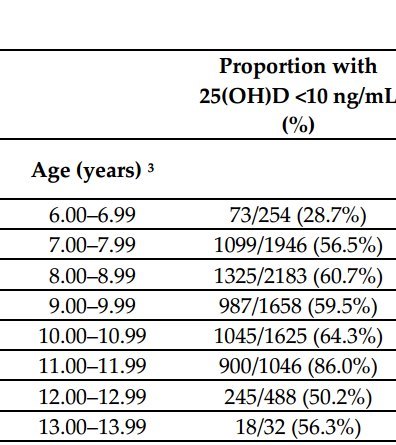Half of Mongolian schoolchildren have less than 10 ng of vitamin D
Prevalence and Determinants of Vitamin D Deficiency in 9595 Mongolian Schoolchildren: A Cross-Sectional Study
Nutrients 2021, 13(11), 4175; https://doi.org/10.3390/nu13114175
by Jorick Bater 1,*ORCID,Sabri Bromage 1ORCID,Tuyatsetseg Jambal 2,Enkhjargal Tsendjav 3,Enkhsaikhan Lkhagvasuren 4,5,Yanjmaa Jutmann 6,Adrian R. Martineau 7 andDavaasambuu Ganmaa 1,8
1Department of Nutrition, Harvard T.H. Chan School of Public Health, Boston, MA 02115, USA
2T School of Industrial Technology, Mongolian University of Science & Technology, Ulaanbaatar 14210, Mongolia
3The Mongolian Health Initiative, Ulaanbaatar 14210, Mongolia
4Ministry of Health, Ulaanbaatar 14210, Mongolia
5Department of Immunology, School of Biomedicine, Mongolian National University of Medical Sciences, Ulaanbaatar 14210, Mongolia
6Department of Math and Statistics, University of North Carolina at Charlotte, Charlootte, NC 28223, USA
7Blizard Institute, Barts and The London School of Medicine and Dentistry, Queen Mary University of London, London E1 4NS, UK
8Channing Division of Network Medicine, Department of Medicine, Brigham and Wome’s Hospital, Harvard Medical School, Boston, MA 02115, USA

Very low D if not Sept-Nov

Population-based data relating to vitamin D status of children in Northeast Asia are lacking. We conducted a cross-sectional study to determine the prevalence and determinants of vitamin D deficiency in 9595 schoolchildren aged 6–13 years in Ulaanbaatar (UB), the capital city of Mongolia. Risk factors for vitamin D deficiency were collected by questionnaire, and serum 25-hydroxyvitamin D (25[OH]D) concentrations were measured using an enzyme-linked fluorescent assay, standardized and categorized as deficient (25[OH]D <10 ng/mL) or not. Odds ratios for associations between independent variables and risk of vitamin D deficiency were calculated using multivariate analysis with adjustment for potential confounders. The prevalence of vitamins D deficiency was 40.6% (95% CI 39.7% to 41.6%). It was independently associated with female gender (adjusted odds ratio [aOR] for girls vs. boys 1.23, 95% CI 1.11–1.35), month of sampling (aORs for December–February vs. June–November 5.28 [4.53–6.15], March–May vs. June–November 14.85 [12.46–17.74]), lower levels of parental education (P for trend <0.001), lower frequency of egg consumption (P for trend <0.001), active tuberculosis (aOR 1.40 [1.03–1.94]), household smoking (aOR 1.13 [1.02 to1.25]), and shorter time outdoors (P for trend <0.001). We report a very high prevalence of vitamin D deficiency among Mongolian schoolchildren, which requires addressing as a public health priority.
📄 Download the PDF from VitaminDWiki
VitaminDWiki: Overview of Rickets and vitamin D contains
{include}
Rickets almost eradicated in counties giving free Vitamin D, perhaps the world can learn – Dec 2019
Low Vitamin D in Mongolia, supplementing would save lives (20 percent have rickets) – Oct 2019
Rickets – 1 in 10,000 in Canada and UK, 1 in 2 in Russia and Mongolia
VitaminDWiki category Deficiency of Vitamin D
{include}
VitaminDWiki categories Deficiency & Infant-child
{category}
VitaminDWiki pages with MONGOLIA in title
This list is automatically updated
{LIST()}
